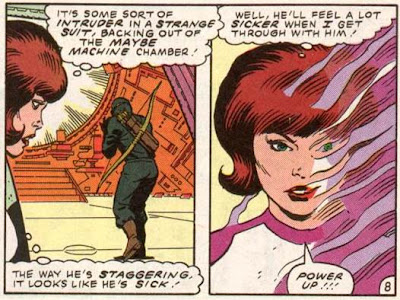Faithful readers of the Legion of Superheroes must have been confused at this sequence, which appeared in Adventure #317:
Why confused? Well, it turns out that this was the first mention of the Time Trapper in a Legion story. At the very end of that story (which mostly did not concern TT) came a semi-explanation:
In the next issue, we got our first glimpse of the villain:
Note in particular his physical appearance there. Over the next year or so, we'd see more futile efforts by the Legion to break through:
The Time Trapper turned out to be working behind the scenes in that story, trying to find out the secret of the Legion's super weapon, the concentrator:
But it turns out that he does not have the real secret of the concentrator and flees into the future again. Amazingly, the Time Trapper story would not be resolved until Adventure #338, almost two years after he was first mentioned:
In that story, the Time Trapper has recruited an evil female, Glorith of Baalour, to help him doom the Legion. We get a strong indication of the plot here:
However, when she tries the trick on several members of the Legion, they do not regress in age past babyhood:
Frustrated in his plot to turn the Legion into blobs of protoplasm, he joins Glorith, after first letting Superboy and Brainiac 5 through the Iron Curtain of Time. He leaves them trapped in the future and sets about training the baby Legionnaires to rob for him:
Then he brings them to a planet where elements in the atmosphere will resume their devolution. But this causes problems, too:
But one of the babies has spotted the Time Trapper's ring, which is responsible for keeping Superboy and Brainiac 5 in the future. He switches it off, allowing them to join the group. The Trapper makes a proposal:
Brainiac 5 agrees, but there is a trick:
End of story? Well, yes and no. Yes, in the sense that it quite literally is the end of the Time Trapper in the Silver Age; he did not appear again outside of a hallucination sequence in Adventure 363.
Which, if you think about it, is very odd. Here's this villain whose confrontation with the Legion had been built up over the course of two years, and yet they dispose of him in a single 16-page story? It doesn't make a whole lot of sense. So I began digging for clues and speculating a bit.
The first clue is that initial mention of the Time Trapper in Adventure #317. It appears obvious that there was supposed to be a Time Trapper story which appeared before that, but which was bumped for some reason. And if we look at the cover to Adventure #317, we get a pretty good second clue:

Speculation: Perhaps the Time Trapper story which appeared in Adventure #338 was intended to appear just before #317, but editor Mort Weisinger belatedly realized that this would give him two consecutive stories featuring Legionnaires turning into babies? This fits, especially when you consider that Adventure #338 was written by Jerry Siegel, while #317 was written by Edmund Hamilton. Weisinger could have instructed Hamilton (or artist John Forte) to include a couple panels mentioning the Time Trapper.
There are certainly still some problems with this speculation. For example, the story does not end with the Time Trapper in the future, creating the Iron Curtain of Time. But this objection is easily overcome; Weisinger simply had the ending of the story rewritten because now it took place after the events in #317, instead of before. Note as well that the story in Adventure #338 did not explain what secret the Time Trapper was supposedly concealing from the Legion in the future.
So my best guess is that the Time Trapper story that was supposed to be published before Adventure #317 was in fact the story that ended up being published in Adventure #338, with some changes.
Incidentally, the Time Trapper himself may have been based on the Time Master, a similar character that appeared in Wonder Woman #101:

























































